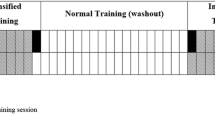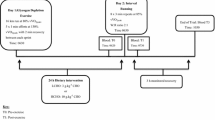Abstract
The present study examined the effect of carbohydrate supplementation on changes in neutrophil counts, and the plasma concentrations of cortisol and myoglobin after intense exercise. Eight well-trained male runners ran on a treadmill for 1 h at 85% maximal oxygen uptake on two separate occasions. In a double-blind cross-over design, subjects consumed either 750 ml of a 10% carbohydrate (CHO) drink or a placebo drink on each occasion. The order of the trials was counter-balanced. Blood was drawn immediately before and after exercise, and 1 h after exercise. Immediately after exercise, neutrophil counts (CHO, 49%; placebo, 65%; P<0.05), plasma concentrations of glucose (CHO, 43%; P<0.05), lactate (CHO, 130%; placebo, 130%; P<0.01), cortisol (CHO, 100%; placebo, 161%; P<0.01), myoglobin (CHO, 194%; placebo, 342%; P<0.01) all increased significantly. One hour post-exercise, plasma myoglobin concentration (CHO, 331%; placebo, 482%; P<0.01) and neutrophil count (CHO, 151%; placebo, 230% P<0.01) both increased further above baseline. CHO significantly attenuated plasma myoglobin concentration and the neutrophil count after exercise (P<0.01), but did not affect plasma cortisol concentration. The effects of CHO on plasma myoglobin concentration may be due to alterations in cytokine synthesis, insulin responses or myoglobin clearance rates from the bloodstream during exercise. Plasma cortisol responses to CHO during exercise may depend on the intensity of exercise, or the amount of CHO consumed. Lastly, cortisol appears to play a minor role in the mobilisation of neutrophils after intense exercise.




Similar content being viewed by others
References
Bishop NC, Blannin AK, Walsh N, Gleeson M (2001) Carbohydrate beverage ingestion and neutrophil degranulation responses following cycling to fatigue at 75% V̇O2 max. Int J Sport Med 22:226–231
Bishop NC, Gleeson M, Nicholas CW, Ali A (2002) Influence of carbohydrate supplementation on plasma cytokine and neutrophil degranulation responses to high intensity intermittent exercise. Int J Sport Nutr Exerc Metab 12:145–156
Bishop NC, Walsh NP, Scanlon GA (2003) Effect of prolonged exercise and carbohydrate on total neutrophil elastase content. Med Sci Sports Exerc 35:1326–1332
Coombes JS, Hamilton KL (2000) The effectiveness of commercially available sports drinks. Sports Med 29:181–209
Dill D, Costill D (1974) Calculation of percentage changes in volumes of blood, plasma, and red cells in dehydration. J Appl Physiol 37:247–248
Feasson L, Stockholm D, Freyssenet D, Richard I, Duguez S, Beckmann JS, Denis C (2002) Molecular adaptations of neuromuscular disease-associated proteins in response to eccentric exercise in human skeletal muscle. J Physiol (Lond) 543:297–306
Jimenez C, Melin B, Koulmann N, Charpenet A, Cottet-Emard JM, Pequignot JM, Savourey G, Bittel J (1997) Effects of various beverages on the hormones involved in energy metabolism during exercise in the heat in previously dehydrated subjects. Eur J Appl Physiol 76:504–509
MacLaren DP, Reilly T, Campbell IT, Frayn KN (1994) Hormonal and metabolite responses to glucose and maltodextrin ingestion with or without the addition of guar gum. Int J Sports Med 15:466–471
Nehlsen-Cannarella SL, Fagoaga OR, Nieman DC, Henson DA, Butterworth DE, Schmitt RL, Bailey EM, Warren BJ, Utter A, Davis JM (1997) Carbohydrate and the cytokine response to 2.5 h of running. J Appl Physiol 82:1662–1667
Nieman DC, Miller A, Henson D, Warren B, Gusewitch G, Johnson R, Davis J, Butterworth D, Herring J, Nehlsen-Cannarella S (1994) Effect of high-intensity versus moderate-intensity exercise on lymphocyte subpopulations and proliferative response. Int J Sports Med 15:199–206
Nieman DC, Nehlsen-Cannarella SL, Fagoaga OR, Henson DA, Utter A, Davis JM, Williams F, Butterworth DE (1998) Effects of mode and carbohydrate on the granulocyte and monocyte response to intensive, prolonged exercise. J Appl Physiol 84:1252–1259
Nieman DC, Henson DA, Smith LL, Utter AC, Vinci DM, Davis JM, Kaminsky DE, Shute M (2001) Cytokine changes after a marathon race. J Appl Physiol 91:109–114
Nieman DC, Davis JM, Henson DA, Walberg-Rankin J, Shute M, Dumke CL, Utter AC, Vinci DM, Carson JA, Brown A, Lee WJ, McAnulty SR, McAnulty LS (2003) Carbohydrate ingestion influences skeletal muscle cytokine mRNA and plasma cytokine levels after a 3-h run. J Appl Physiol 94:1917–1925
Petrides JS, Gold PW, Mueller GP, Singh A, Stratakis C, Chrousos GP, Deuster PA (1997) Marked differences in functioning of the hypothalamic–pituitary–adrenal axis between groups of men. J Appl Physiol 82:1979–1988
Roy BD, Tarnopolsky MA, Macdougall JD, Fowles J, Yarasheski KE (1997) Effect of glucose supplement timing on protein metabolism after resistance training. J Appl Physiol 82:1882–1888
Sayers S, Clarkson P (2003) Short-term immobilization after eccentric exercise. Part II: creatine kinase and myoglobin. Med Sci Sports Exerc 35:762–768
Schwarz L, Kindermann L (1989) Beta-endorphin, catecholamines, and cortisol during exhaustive endurance exercise. Int J Sports Med 10:324–328
Steensberg A, Fischer CP, Keller C, Moller K, Pedersen BK (2003) IL-6 enhances plasma IL-1ra, IL-10, and cortisol in humans. Am J Physiol 285:E433–E437
Suzuki K, Totsuka M, Nakaji S, Yamada M, Kudoh S, Liu Q, Sugawara K, Yamaya K, Sato K (1999) Endurance exercise causes interaction among stress hormones, cytokines, neutrophil dynamics, and muscle damage. J Appl Physiol 86:1360–1367
Suzuki K, Nakaji S, Yamada M, Liu Q, Kurakake S, Okamura N, Kumae T, Umeda T, Sugawara K (2003) Impact of a competitive marathon race on systemic cytokine and neutrophil responses. Med Sci Sports Exerc 35:348–355
Tabata I, Ogita F, Miyachi M, Shibayama H (1991) Effect of low blood glucose on plasma CRF, ACTH, and cortisol during prolonged physical exercise. J Appl Physiol 71:1807–1812
Thomas JR, Salazar W, Landers DM (1991) What is missing in P<0.05? Effect size. Res Q Exerc Sport 62:344–348
Trinder P (1969) Determination of glucose in blood using glucose oxidase with an alternative oxygen acceptor. Ann Clin Biochem 6:24
Viru A, Karelson K, Smirnova T (1992) Stability and variability in hormonal responses to prolonged exercise. Int J Sports Med 13:230–235
Acknowledgements
The authors thank the athletes who participated in this study for their time and effort.
Author information
Authors and Affiliations
Corresponding author
Rights and permissions
About this article
Cite this article
Peake, J., Wilson, G., Mackinnon, L. et al. Carbohydrate supplementation and alterations in neutrophils, and plasma cortisol and myoglobin concentration after intense exercise. Eur J Appl Physiol 93, 672–678 (2005). https://doi.org/10.1007/s00421-004-1248-5
Accepted:
Published:
Issue Date:
DOI: https://doi.org/10.1007/s00421-004-1248-5




